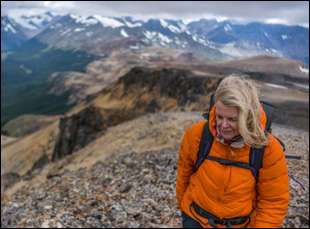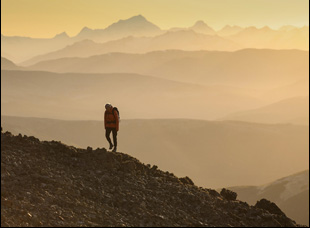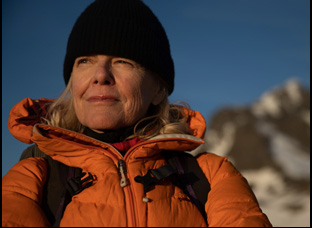Even as Jimmy Chin and E. Chai Vasahelyi have ascended to the top of their craft after first joining forces in film and in life during the making of “Meru,” their work together has only grown to come across more effortless, having the feeling as Chin so often did in his days climbing mountains, of swapping stories around a campfire where everyone has something to add, perhaps centered on the person who reaches the summit but sure to include all the others who helped get them there. It was why in “Free Solo,” they weren’t about to overlook the support that Alex Honnold’s then-girlfriend, now-wife Sanni McCandless gave to the rock climber on his bare-handed scaling of El Capitan, and only they could deliver the definitive version of the extraordinary 2018 efforts of a group of cave divers to bring a Thai boys’ soccer team to safety in “The Rescue,” understanding that before the divers could even thread the needle of navigating the tight underwater spaces that so many other channels bureaucratically, culturally and logistically had to be cleared first for cooperation.
In this sense, Chin and Vasarhelyi were the only filmmakers that were suited to make “Wild Life,” though one could easily think that two of the film’s main subjects Kristine Tompkins and Rick Ridgeway, who first showed Chin how to use a camera during their climbs together, thought of them for other reasons as well. Filming off and on for the past seven years, Chin and Vasarhelyi were let into the darkest moments of Tompkins’ life when her husband Doug, accompanied by Ridgeway, died in a kayaking accident in Chile, where the couple had rededicated their life to land preservation in Patagonia after making their fortune, along with Yvon Chouinard, with the clothing company of the same name. Death has been seen as an acceptable risk for the adventurers in Chin and Vasarhelyi’s work to see what people can be capable of, but here it appears as completely crushing at first to Tompkins, who openly wonders whether she can continue on without Doug in the fragile moments after learning of his death.
For seven years, Chin and Vasarhelyi take on two byzantine tasks in “Wild Life,” sensitively tending to their own circle of friends as they debate how best to carry on the conservationist’s legacy and corralling their collective life’s work to date, charting friendships that date back to the 1960s when Doug Tompkins, Ridgeway and Chouinard would first cross paths as surfers and mountain climbers and eventually parlay the trust from their excursions into a number of enormously successful businesses from North Face to Esprit and eventually, Patagonia. However, “Wild Life” never feels as if it’s told in the past tense when Kristine Tompkins, an executive at Patagonia, describes her love for Doug after Chouinard first introduced her to him or for their shared passion for the environment, ultimately leading the two to come up with the brilliant albeit expensive plan to begin buying up land in Chile to give back to its people, ensuring that critical territories aren’t conscripted for exploitation and any requisite pollution. It isn’t only witnessing Tompkins see the project through that’s inspiring, understanding the great emotional toll it takes on her without her partner around to see it, but the filmmakers’ own dedication to following the story wherever it leads, building as impressive a view of what Tompkins and Ridgeway have had to endure emotionally as vividly as their typically exquisite depiction of some of the world’s most majestic topography.
After premiering last fall at Telluride and enjoying a theatrical tour this spring, “Wild Life” just touched down on Disney+ and Hulu and Chin and Vasarhelyi recently spoke about the high bar they set for themselves in agreeing to make a movie and getting their arms around a history with such twists and turns and highs and lows.

Chai Vasarhelyi: We dread making movies just altogether because of the commitment that’s going to go into it. If we decide to make a movie, it’s all in and I talk about it like getting married again, or starting a new PhD. For this one, it was tricky because this is a film which features like some people who are really, really important to Jimmy and we’re in a place in our career where that’s really nice, but we have created quite an authentic style with great integrity and great intention, so that just made me nervous. But it was when I personally witnessed Kristine Tompkins pick herself up again, having experienced the death of her husband who she was madly in love with and find the strength to see their vision through to create these national parks. I was really moved on a personal level and then additionally, our kids are now nine and seven and we’ve seen over and over again, their visceral fear about climate change. Here was a story that demonstrated with heart and grit and ups and downs this idea that we all can do something and we will.
Jimmy, knowing many of the people as you did, and Chai didn’t, was that interesting to have those dual perspectives to figure out what the story was?
Jimmy Chin: Sure, I think my friendship and being brought into that family of friends, ultimately allowed us to access to their story, which would probably never have happened otherwise. And Kris has said to us that she would not have made the film with anybody else. But that kind of friendship and relationship, while very important in getting us access, can also be a challenge. And Chai came into it with much more objectivity and was able to look at it from another point of view. more critical point of view. That’s our strength in what we do is that we come from such different points of view. Our relationships often with the subjects are different, and that allows us to explore different aspects of the story.
Chai Vasarhelyi: And that’s one of the great challenges of most of our films, and like this one especially, where the action spans over 60 years, there’s so many interesting people who are part of this and it was really, really, really hard to find the right balance between the various strands of the story. It happens in so many different parts of the world, and it could be a Doug movie, and Yvon [Chouinard] movie, a Kris movie, a buddy movie — it could be an Esprit movie, a Patagonia movie or a North Face movie. It could be lots of movies. But when we understood Kris as the pulsing heart and you can see Kris evolve and assume her voice, that’s when it was very clear. We’ve been working on this film for seven years and it was really towards the end where when we tried to move Doug’s death to the beginning of the film, that whole film opened up. Because once you could lay that groundwork, you can let him die, and then you can tell the story of how [Kris] came to be, it really allowed her story to soar.

Chai Vasarhelyi: This really could have been an eight-part series, and the greatest craft or construction question was actually when we showed a version of this film at the Telluride Film Festival this fall, and we understood we were missing the middle because the middle is actually the hard work — the hard work of how to build a park, how to do the work necessary to convince local communities to go along with it, and how to work with the government. It’s not necessarily sexy, but it’s important and it is what the work was, so it’s just a constant balancing act for us. And the Patagonia archives lived in Tupperware bins because they’re just not interested in self-chronicling. The ethos of that whole company and Kris and Yvon is let’s walk the walk and not talk the talk, but we had to be like, “No, let’s digitize those,” and it’s been that process of unraveling, going deeper and trying to see what works and then making some really hard decisions.
Kris’ journals, which covers decades, seem like a really important part of this. What was that like to get your hands on?
Jimmy Chin: It’s always part of our process to get everything we can possibly get our hands on because when we embark on this journey, we don’t know what kind of vehicle we will be able to use to best tell it. We knew that she was a beautiful writer. We knew that she had been writing these diaries, particularly after Doug died, so we asked for everything and when she handed it all over, we dug through everything. As you see in the film, it was a perfect tool for us to use in multiple ways, and ultimately it’s such a personal, deep, authentic voice.

Jimmy Chin: Well, I know Rick and Yvon much better, and I knew Doug and Kris, having spent a bit of time with them, but I knew more of their reputation and getting the inner story, the romantic stories that most people don’t share publicly, that part of it was very moving.
Chai Vasarhelyi: I never expected the physicality of their love for each other, like the eroticism or the spiciness to this and I felt great pleasure in discovering it. It made me just feel like the world is that much more alive and it made me happy for them. It also helped me access just what a loss it was for her [when Doug died], [because] they really loved each other and this idea of finding love later in life and finding such complete love, I found very moving.
Jimmy Chin: We kind of knew it was there, and obviously this film is hinges on this beautiful love story, but to have [Kris] give that up to us and hear everybody else’s perspective on what they had seen, that was very moving for us.
Respect for nature has always been a part of your films, but was speaking to that more explicitly interesting?
Jimmy Chin: We always understood that one of the characters in the film was the landscape that they were trying to save and to protect, and what better way to express why they were passionate about it than by showing the beauty of this incredible landscape that they were trying to protect, so we did put a lot of effort into trying to bring to life all of these incredible landscapes. And the thing about Patagonia, it’s 15 million acres. It covers all kinds of different types of landscapes from high Alpine deserts to coastline to these incredible lakes and waterfalls and just such a diverse kind of spread of ecosystems.

Chai Vasarhelyi: It’s a few things. We feel really proud that audiences are coming out to theaters to see a documentary, and the theatrical business has really been hurting — it was already hurting before the pandemic, and it’s been one of those amazing things to see everyone come out and have this communal experience. Seeing young people and old people crying and getting really worked up and coming out of the woodwork to have this shared experience makes the filmmaking feel important and feel relevant. Besides that, I just hope that this proactive, positive story about climate change and what we can do is inspiring and somehow like both a battle cry, a call to arms, but also just like a reminder of what we share and why that’s sacred.
Jimmy, when Rick was one of the first people to show you how to use a camera, what’s it like to be able to present him with a film like this?
Jimmy Chin: It’s been very special. He invited me on my first National Geographic expeditions, which was a very pivotal moment in my career as a photographer and a visual storyteller, but he also taught me how to film and the basics of shooting a scene — how to follow, who to follow, and how much to roll, then after the trip he also sat with me to go through the edit of all the stuff that I had shot. It was a hugely educational and informative part of my early career, so it is like it’s come full circle. That’s been very satisfying as well as that group of friends who really has taken me under their wing in my twenties. They really defined a lifestyle and ethos that I have aspired to live by since I met them and it’s been very gratifying to bring their story to life.
“Wild Life” is now streaming on Disney+ and Hulu.




